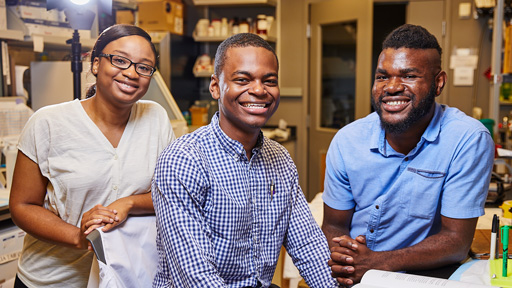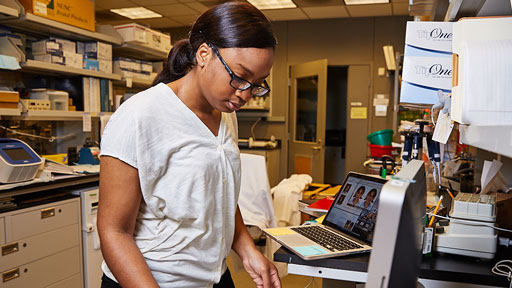"Places [like Liberia] don't have the necessary resources or research in times of outbreak," said Ms. Sannoh. "That's why I want to be an epidemiologist: to work in the field with people and help fight infectious diseases."
Last year, the Prince George's County, Maryland native was one of the first students to participate in the High School Scientific Training and Enrichment Program (HiSTEP), one of four internship subprograms in the National Institutes of Health's (NIH) Summer Internship Program in Biomedical Research (SIP). The program launched in 2015 to increase the participation of students from underrepresented backgrounds in science.
"Each year, eight thousand to 10 thousand applicants compete for one thousand spots in the summer internship program at NIH," said Belen Hurle, Ph.D., internship coordinator for the National Human Genome Research Institute (NHGRI), one of the 26 participating institutes and centers at NIH. "The talent, passion, and motivation of the students we recruit every year never cease to surprise me."
First-year HiSTEP interns are introduced to research through an intensive boot camp that builds scientific, professional and personal skills through leadership training. Students also benefit from informational interviews and extensive networking opportunities with future research mentors. During their second year, interns gain hands-on research experience by joining a world-class NIH research laboratory.
As an HiSTEP intern within the Bonham Lab in the health disparities unit at NHGRI, Ms. Sannoh's research focused on sickle cell disease (SCD) and the factors that influence why some patients with SCD get leg ulcers and others do not. Ms. Sannoh's project focused specifically on studying fetal hemoglobin in the blood to see if its presence provides some sort of protection against leg ulcers.
Giving community college students a boost
Charlotte Hepler, a Northern Virginia Community College student, was eyeing a career in substance abuse counseling but didn't have access to the scientific research experience she needed to round out her skill set -- a common dilemma for community college students.
Everything changed during a chance encounter at the 2015 NIH Community College Day. There, she learned about the Community College Summer Enrichment Program (CCSEP), another subprogram of the NIH SIP, specifically aimed at providing community college students with experience in the biomedical sciences.
"Had it not been for Community College Day, I wouldn't have been able to work at NIH this summer," said Ms. Hepler.
As a 2016 summer intern, Ms. Hepler was selected by Barbara Biesecker, Ph.D., associate investigator and head of the Genetics Services Unit at NHGRI, to work alongside investigators studying clinical translation of genomics in the institute's Social and Behavioral Research Branch. Ms. Hepler focused her research project on the motivations of participants enrolled in genomic research to assess expectations from clinical sequencing. She was particularly interested in the differences between healthy and unhealthy participants and their hopes for personal gain from the information. Such findings can inform future consent practices in genome sequencing.
"The most important thing I've learned this summer is that scientific research isn't predetermined," said Ms. Hepler. "It involves setting a hypothesis, testing, and re-testing. It's a process that is challenging but also rewarding."
Accelerating graduate school researchers
Richard Sawyer was your typical "pre-med" student on track to become a physician. But an undergraduate summer internship conducting research at Virginia Tech in Blacksburg, Virginia, convinced him of the need for clinical research to meet major public health challenges.
"It's always the hope that you can help someone," said Mr. Sawyer. "If you can't help them immediately, I'd want them to know I'm looking for answers."
That's exactly what Mr. Sawyer did in the laboratory of Phillip Shaw, BMBCh. (Medicine), Ph.D., in NHGRI's Social and Behavioral Research Branch. He worked with scientists to find the underlying cause of Attention Deficit Hyperactivity Disorder, or ADHD, by identifying and comparing changes in the genetic code and brains of children with and without ADHD.
Now a graduate student, Mr. Sawyer is one of the first to participate in NIH's Graduate Summer Opportunity to Advance Research (GSOAR) program. During their internships, scholars are matched with research mentors in the NIH Intramural Research Program.
"I have the opportunity to do research that you can't do at other places," said Mr. Sawyer. "I am doing clinical research using brain imaging data acquired on more than two thousand children from many research groups in the and beyond."
His advice to future NIH interns?
"Take advantage of the time you have here at NIH, and do as much as you can," he said.
The application window for the 2017 NIH Summer Internship Program opens November 15, 2016 and closes March 1, 2017. For more information or to apply, visit the NIH SIP homepage.



